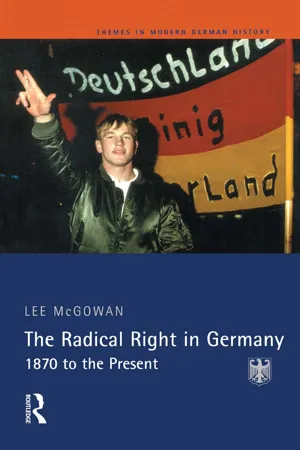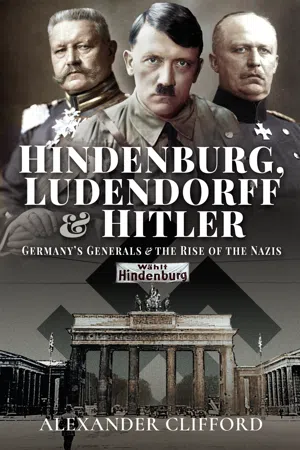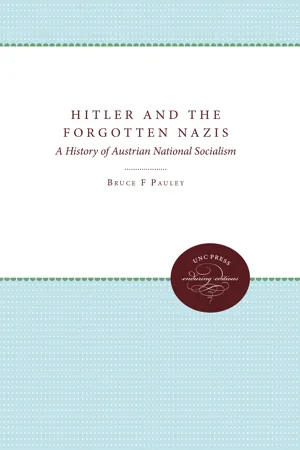History
Kapp Putsch
The Kapp Putsch was a failed coup attempt in 1920 in Germany, led by Wolfgang Kapp and supported by right-wing nationalist groups and the Freikorps. The coup aimed to overthrow the Weimar Republic and establish a right-wing government. Despite initial success, the coup collapsed due to a general strike by workers and lack of support from the military.
Written by Perlego with AI-assistance
Related key terms
1 of 5
6 Key excerpts on "Kapp Putsch"
- eBook - ePub
The Radical Right in Germany
1870 to the Present
- Lee Mcgowan, Lee McGowan(Authors)
- 2014(Publication Date)
- Routledge(Publisher)
This putsch represented the first serious attempt to overthrow the democratically elected government and was led by Wolfgang Kapp, formerly one of the leaders of the Fatherland party and garnered the sympathy of many representatives of the old right, including former high-ranking army officers such as Ludendorff, civil servants and DNVP deputies. Few of these, however, were prepared to risk their political future on so half-baked an adventure and the coup collapsed once it failed to secure a wider support base across the country and following a government-orchestrated general strike that paralysed Berlin. The episode is significant as it underscored the potential threat posed by the German right. The assertiveness of the far right was in evidence in many parts of Germany and particularly acute in Bavaria where, for example, the Bund Bayern und Reich (Bavaria and Reich League) placed growing pressure on the Bavarian authorities to resist compliance with Germany’s disarmament obligations and demanded the restoration of the Bavarian royal family and even contemplated the separation of Bavaria from the Reich until the threat posed by bolshevism had been countered. Their nationalist leanings were symptomatic of many right-wing groups and were reflected in a growing militancy that encapsulated the activities of groups such as the Bund Oberland which took part in fighting in the Ruhr and in Upper Silesia and assumed a new stage of escalation when the right-wing terrorist Organization Consul (which comprised mostly young and disaffected ex-officers) assassinated two of the Republic’s strongest advocates, namely the Centre Party politician, Matthias Erzberger (who had signed the Versailles Treaty on behalf of the German government), in August 1921 and Walther Rathenau, the Jewish-German Foreign Minister, in June 1922 - No longer available |Learn more
Hindenburg, Ludendorff and Hitler
Germany's Generals and the Rise of the Nazis
- Alexander Clifford(Author)
- 2023(Publication Date)
- Pen & Sword Military(Publisher)
107 Wolfgang Kapp returned to Germany in 1922 to face the music but died in prison while awaiting trial. An amnesty for those involved in the Kapp Putsch meant that in 1925 Walther von Lüttwitz was able to return and quietly live out his years on a full military pension. 108 Colonel Bauer was also able to return from exile in Hungary at the same time. Personnel from Marine Brigades Ehrhardt and Loewenfeld who did not flee were simply transferred to the navy, where the spirit of the Freikorps lived on undiminished – the only measure taken in retribution for the navy’s full support of the putsch was the sacking of its chief, Rear Admiral von Trotha. 109 While the Freikorps were dissolved in the coming months in accordance with Versailles, many units were integrated into the Reichswehr and in the case of those more extreme elements that were not (such as Ehrhardt loyalists), paramilitary activity continued underground, especially in Bavaria. 110 In the aftermath of the coup, Lüttwitz’s demand for early elections was actually met, with the country going to the polls in June 1920. The results dismayed republicans; the so-called Weimar coalition of centre-left to centre- right parties most committed to democracy (the SPD, DDP and Centre) that had governed since January 1919 lost their majority in the Reichstag, never to regain it. Kapp had brought rightist opposition to democracy out into the open and support for the Weimar coalition dropped from 76 per cent to just 45 per cent. While Catholics mostly remained loyal to their Centre Party, huge numbers of working-class voters punished the SPD for its compromises with the establishment, its crushing of the revolution and its use of the Freikorps by switching their allegiance to the more radical USPD and KPD. Meanwhile, the middle class moved away from the liberal DDP (which lost nearly half its seats) in favour of the monarchist DVP and nationalist DNVP, parties with limited commitment to democracy. - eBook - ePub
Dragonslayer
The Legend of Erich Ludendorff in the Weimar Republic and Third Reich
- Jay Lockenour(Author)
- 2021(Publication Date)
- Cornell University Press(Publisher)
138Many on the right, including Alfred von Tirpitz, considered the move ill-timed and poorly planned.139 Max Weber feared that the repercussions of the Kapp Putsch would lead to the dissolution of the Reich. In a letter to his sister in May 1920 he worried about Bavarian separatism and leftist uprisings, writing that “if the Reich breaks up, then it will have been the work of these people (Kapp, Lüttwitz, and I fear I must add Ludendorff).”140 When the putsch seemed likely to call forth the very leftist revolution it was supposed to prevent, most of its potential allies and friends deserted it.141Ludendorff found little sympathy in Berlin. Captain Ehrhardt posted a twenty-four-man bodyguard around Ludendorff’s house. He blamed the failure of the putsch on inadequate preparation and on the disloyal and selfish behavior of so many officers unwilling to follow Lüttwitz’s lead.142 Ludendorff fled at the end of March for the safety of Bavaria, where wealthy nationalists sheltered him, first in a castle overlooking the Inn Valley, then, near Rosenheim at the home of Baron von Halkett.143 In August of the same year, he rented a house overlooking the Isar River near Munich in Ludwigshöhe.144 The Munich Schutzpolizei provided Ludendorff with a car and an “adjutant” to accompany him as he traveled around the city.145Few of the main conspirators received any kind of punishment. Several were indicted but not tried. Lüttwitz found shelter in Silesia with friends. Kapp fled to Sweden, Bauer and Ehrhardt to Munich. Only Traugott von Jagow served any time.146 Ludendorff managed to avoid even the indictment for high treason that fell on Kapp, Bauer, and the others. The cabinet initially deemed it too dangerous to arrest Ludendorff. Seeckt agreed that for the sake of the troops—and because Ludendorff had not “actively participated”—his arrest was not necessary.147 Ludendorff’s reliance on Bauer as a go-between and his refusal to participate directly in the putschists’ activities allowed him to keep his freedom.148 - eBook - PDF
- Harold J. Gordon(Author)
- 2015(Publication Date)
- Princeton University Press(Publisher)
77 See Chapters xi and xu below. " B , ii, MA103476, pp. 1163, 1406; NA, EAP 105/7, n, p. 32. 79 B, i, SA 1, 1490, Troger, p. 53; n, MA103476, pp. 8, 1198-1202, 1204, 1332-34, 1341, 1457; GP, A, Eberhard Dennerlein, 29.2.1960. 8 0 B, n, MA103476, pp. 1044, 1107, 1110, 1204. The Coming of the Putsch · 263 both the carrot and the stick. They had plans for drumhead courts martial to deal with political enemies in summary fashion, but they also set up a propaganda office to influence the population. They even arranged for printers to stand by to produce material for the Kampfbund during the night, although allegedly they did not. tell the printers what their work would be. 81 Finally, the Putschists ar- ranged for the establishment of recruiting stations for all of their organizations and printed placards directing the public to them. 82 Ironically, there were also personal preparations for the Putsch on the part of those "in the know." It is always hard to keep insid- ers on the stock market from taking advantage of their knowledge to help themselves. The Putschists apparently faced the same prob- lem, since, despite the danger of alerting the authorities, Gottfried Feder tried to withdraw his securities from his bank the day of the Putsch and made a most surprising commotion when informed that this would be impossible. Since he had in his pocket a decree writ- ten by himself freezing all bank accounts on behalf of the new gov- ernment, his actions are perhaps understandable, but not easily condoned in one who bled so vigorously over the financial cor- ruption of the Republic. The other, and more successful, Putschist was Ludendorff, who cleaned out his account two days before the Putsch. The general was cautious with his funds as well as with his political commitments. 83 At the same time the Kampfbund adopted confusion tactics aimed at misleading both its opponents and the general public. - eBook - ePub
The Lost Revolution
Germany 1918 to 1923
- Chris Harman(Author)
- 2017(Publication Date)
- Haymarket Books(Publisher)
Yet overall, the right wing generals had prompted the beginnings of a new revolution in their efforts to bury the last remnants of the old. The situation was rather similar to that in Spain in July 1936, after Franco’s military uprising. The right wing army coup provoked a counter-rising of the workers. But this could not content itself with merely attacking the open supporters of the coup. The workers understood that if Kapp and Lüttwitz were successful, the rest of the military would soon swing behind them. The whole officer corps yearned for the days before the November Revolution, not just a few backwoodsmen.Many workers had opposed the Spartakists in January 1919, had stood back when the Freikorps marched into Berlin and Bremen, had considered the Ruhr strikers extremists, and had accepted the Social Democrats’ reasons for crushing the Bavarian Soviet Republic. Now they could see that not only the ‘extremists’, but they themselves were under attack, and they followed the call of local left Independents and Communists to destroy the power structure that had made the Kapp Putsch possible. In doing so they began to create new alternative power structures—structures of workers’ power—alongside the old.Within three or four days of the coup, the authority of the state no longer held sway in some of the main industrial centres of Germany. The military forces that had lorded over the country as they marched from one end to the other in 1919, had suffered defeat in battle. They began to lose all confidence once they faced, not one section of workers fighting while another section a few miles away stood back, but simultaneous risings in many different places. What is more, the railway strike prevented them from moving fresh troops to aid besieged local garrisons.Kapp backs outIn Berlin Kapp’s supporters found themselves in a bewildering position. They had carried through a highly effective military coup: in military terms it was not a putsch, a failure, but a very successful operation. Half the army was supporting them and the other half was merely waiting to make sure the coup was a success before doing so. The right wing parties recognised their rule. - eBook - ePub
Hitler and the Forgotten Nazis
A History of Austrian National Socialism
- Bruce F. Pauley(Author)
- 2017(Publication Date)
- The University of North Carolina Press(Publisher)
14 Some of it was directed against public buildings, barracks, prisons, and other government buildings as well as against judges, police officials, and politicians. Most explosions, however, occurred near tourist areas, waterworks, and power plants.It is impossible to say who was responsible for this complete collapse of the “evolutionary” policy initiated in March. As the leader of the Austrian party, however, it was Theo Habicht who bore the ultimate obligation to control these activities. The consequences of the party’s reckless defiance of international law were the diplomatic isolation of Germany and the near destruction of the party itself.The climax of the new wave of terror came early in the afternoon of 25 July when 154 members of the Viennese SS Standarte Eighty-nine, disguised in uniforms of the Austrian army, broke into the federal chancellery on the Ballhausplatz in Vienna and mortally wounded Engelbert Dollfuss. This act was just the beginning of the notorious July Putsch, which ended three days later after 153 Nazis had been killed in battle (or later executed) and thousands more had fled to Germany and Yugoslavia.The story of the Putsch, which has been told and retold in almost excruciating detail, need not be repeated here. Still of interest, however, is what induced the Austrian Nazis to take this desperate gamble, why the action misfired, and what impact its failure had on the subsequent history of the illegal party.The idea of a Putsch was an old one. The first rumors of a plot to overthrow the government reached the German Legation in Vienna on 26 July 1933, only five weeks after the party had been outlawed. This plan, to be carried out in September, was never implemented. The SA also began to work on Putsch plans during the summer, which led to conversations in October between Ernst Röhm, Hermann Reschny (the leader of the Austrian SA), Habicht, and Proksch. At a meeting in Passau the conspirators agreed that the Putsch should take place on 9 November (the tenth anniversary of the Beer Hall Putsch). It was supposed to begin in the Nazi stronghold of Carinthia and lead to a nationwide strike. A lack of weapons in Carinthia, however, prevented the execution of this plan.15
Index pages curate the most relevant extracts from our library of academic textbooks. They’ve been created using an in-house natural language model (NLM), each adding context and meaning to key research topics.





